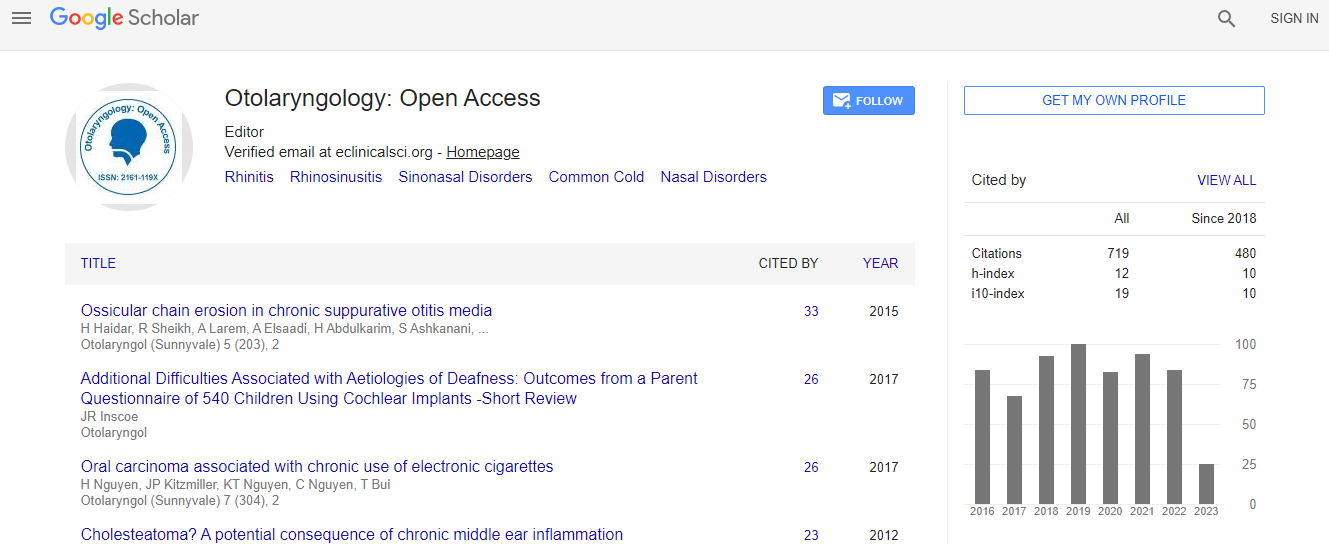Our Group organises 3000+ Global Conferenceseries Events every year across USA, Europe & Asia with support from 1000 more scientific Societies and Publishes 700+ Open Access Journals which contains over 50000 eminent personalities, reputed scientists as editorial board members.
Open Access Journals gaining more Readers and Citations
700 Journals and 15,000,000 Readers Each Journal is getting 25,000+ Readers
Google Scholar citation report
Citations : 925
Otolaryngology: Open Access received 925 citations as per Google Scholar report
Otolaryngology: Open Access peer review process verified at publons
Indexed In
- Index Copernicus
- Google Scholar
- Sherpa Romeo
- Open J Gate
- Genamics JournalSeek
- RefSeek
- Hamdard University
- EBSCO A-Z
- OCLC- WorldCat
- Publons
- Geneva Foundation for Medical Education and Research
- ICMJE
Useful Links
Recommended Journals
Related Subjects
Share This Page
The effect of performing investigations on the management of tonsillitis and quinsy patients
3rd International Conference and Exhibition on Rhinology & Otology
Mohd Afiq Mohd Slim, Philip Bell and Marcel Valko
Antrim Area Hospital, UK
Posters & Accepted Abstracts: Otolaryngology
Abstract
Background: Tonsillitis and quinsy remains a common acute in-patient admission into an Otolaryngology unit. Nevertheless, there is lack of specific guidelines for secondary care. Resource utilization within the secondary care remains puzzling. Aim: The primary aim was to assess our centre 2014 practice regarding throat swabs/pus sample (TSPS) and Monospot test (MT) for tonsillitis and quinsy. The secondary aim was to analyze the effect of the investigations on the management. Methodology: Retrospective data collection from the year 2014 was performed from a single ENT unit. List for patients admitted and diagnosed with √ʬ?¬?Tonsillitis√ʬ?¬?, √ʬ?¬?Quinsy√ʬ?¬?, √ʬ?¬?Peritonsilar Abscess√ʬ?¬? or √ʬ?¬?Glandular Fever√ʬ?¬? was obtained from the Hospital Information Office. The Electronic Care Record system was used to obtain the data needed. Fisher√ʬ?¬?s Exact were performed to analyze the data. Results: 69 patients accounting for 72 episodes of admission occur in the year 2014. Mean age was 27.87 years old with Male: Female ratio of 38:31. Overall, 35.2% did not have any investigation. 64.8% had at least more than one investigation accounting for 25% of TSPS and 48.6% MT. The amount of investigations perform did not change the management (Fisher√ʬ?¬?s exact F=0.5973). The estimated overall cost to detect one positive monospot test per 100 patients was 911.76gBP and 450gBP to grow a positive throat swab/pus sample per 100 patients. Conclusion: MT should only be performed in those within a high risk group patient. TSPS are not routinely sent as it will not alter the management in 48 hours.Biography
Email: chain1993@yahoo.com

 Spanish
Spanish  Chinese
Chinese  Russian
Russian  German
German  French
French  Japanese
Japanese  Portuguese
Portuguese  Hindi
Hindi 
